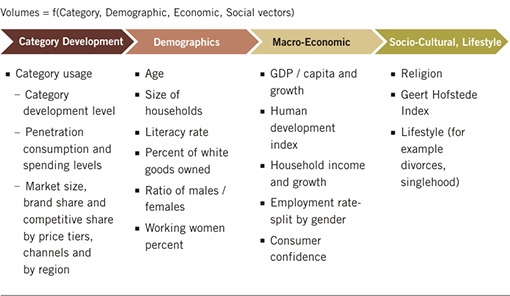Market size estimation is integral to the expansion strategy of every growing organization, whether it is in terms of entering new markets or identifying opportunities to grow in existing markets.
What is Old is Not Always Gold
Market reports have been the mainstay of consumer product companies in strategy formulation over the years. Major investment decisions regarding new and existing markets have traditionally been based on information collated from these reports. This approach is, however, fraught with risks. Organizations have to depend on inferences drawn from these reports, and do not have access to the raw data on which the inferences are based. Additionally, many of these reports use simple projections, such as the CAGR index, to recommend complex market trends and patterns.
Market forces and consumer preferences are highly dynamic and have become more multi-faceted with time. The need-of-the-hour is, therefore, a more robust and comprehensive analytical technique that covers all the relevant factors, such as consumer demographics, macro-economic and socio-cultural factors and the category development levels of each category of product.
Treading the WNS Path
The success and efficacy of market reports depend to a large extent on the data sources, and the way the data is used.
- We do use data from a wide variety of sources, including the client's own resources and secondary sources.
- The range of data used to make projections is much wider (consumer demographics, macro-economic, socio-cultural, category development levels). This data is then modelled using advanced statistical techniques for accurate projections of market size.
- We provides further slicing and dicing of data to enable drill-down of projections by product sub-categories, regions, consumer and demographic breaks and type of channel.
- Data and model refreshing in a time-bound manner helps carry out regular updates for business.
- We provide the client dashboards and tools, which helps data to life. This enables faster and superior decision- making since such tools can be hosted on the company's Intranet or Internet and allow information to be shared across the organization seamlessly. Which helps transforming routine data into actionable insight.
The WNS approach to estimating market size provides a more comprehensive view of the market. Volume forecasting helps elicit focused trends, such as penetration, consumption and spending patterns, growth across various geographies, gender-specific growth and so on. The following are some of the key features of the exercise:
- Region-specific: The overall market numbers are split by region to assess the potential and to be targeted.
- Consumer type and gender-wise splitting: We analyze the growth of various products by gender and consumer type across regions to identify opportunities for increasing penetration, consumption and spending.
- Sales-channel focused: The client has the visibility into sales volumes across different sales channels.
- Competition-wise split: The market is sliced to understand the strength of the main players across product categories. This gives the client clear visibility across brands competing with it.
The WNS Market Size Estimation Approach
Exhibit 1 (below) gives an idea of the type of vectors WNS uses to arrive at a comprehensive volume assessment report.
Capturing the impact of macro-economic, social, category and demographic vectors on forecasts

In conclusion, WNS's market size estimation solutions free your valuable internal resources from time-consuming tasks like searching for data and collating it. They provide in-depth and accurate insights by stitching multiple data sets to identify how the market will evolve in the years ahead, and identify opportunities for growth based on how numbers will split across regions, genders, brands and sales channels. WNS's solutions enable you to align with the market dynamics, and respond to challenges and opportunities faster.